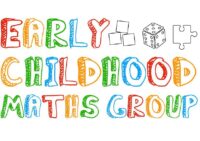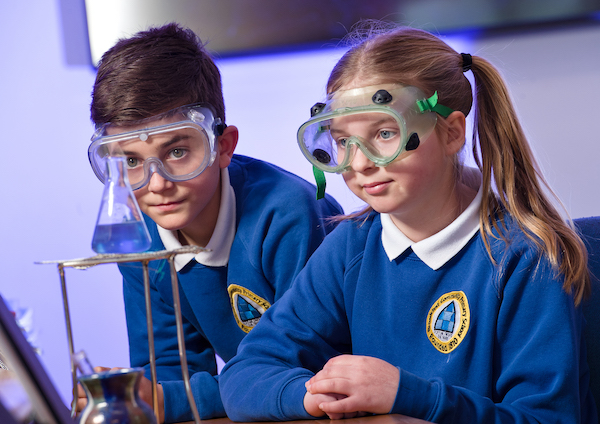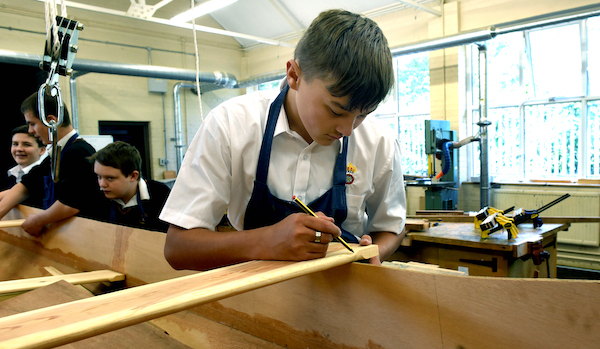The importance of spatial thinking for STEM
- When you visit a new town, are you good at finding your way around?
- Are you a champion dishwasher stacker?
- Can you easily follow instructions to make LEGO® models or flat-packed furniture?
- Can you visualise how to rotate your shoes so that they nest together in the shoe box?
- Can you easily interpret graphs and diagrams?
The everyday activities above require spatial ability. Spatial ability involves perceiving the location, dimension and properties of objects and their relationships to one another. Not only is spatial ability core to everyday living, but spatial ability in childhood predicts adult expertise in Science, Technology, Engineering and Mathematics (STEM) (Wai et al., 2009). This is unsurprising, given many examples of spatial skills that are integral to STEM professions (e.g., understanding graphs and electronic configurations).
Engineering, a key STEM industry, annually contributes 21.4% (£1.2 trillion) to the UK economy (Engineering UK, 2018), yet over £1.5bn in losses are reported per year due to STEM skills shortages (IET, 2021). Despite the importance of spatial thinking, educational policy in England has very limited focus on spatial thinking, particularly when compared to the importance placed on literacy skills.
Not only is spatial ability core to everyday living, but spatial ability in childhood predicts adult expertise in Science, Technology, Engineering and Mathematics.
One way to address school readiness is to look beyond subject knowledge and to place a higher value on spatial thinking skills, as measured by CAT4.
GL Assessment’s recent YouGov poll indicated that primary and secondary teachers are concerned about school readiness for students starting Y7 this year. One way to address school readiness is to look beyond subject knowledge and to place a higher value on spatial thinking skills, as measured by CAT4.
Spatial activities are effective in improving spatial thinking skills and are a means to improving academic attainment in STEM subjects (Uttal et al., 2013). For example, it has been consistently demonstrated that spatial training increases primary and secondary achievement in mathematics (Hawes et al., 2022). This is logical, given that understanding science and mathematics depends heavily on being able to read diagrams, rearrange formulae and interpret representations at different scales.
Similarly, mathematics requires an understanding of shape, symmetry and numerical relationships, all of which require spatial skills, whilst the core problem solving and interpretation skills that are drawn upon in STEM subjects require visualisation, a key spatial skill.
Spatial thinking in the classroom
There are measures and strategies that practitioners can adopt to nurture spatial thinking. For children with high spatial ability (see Samira’s story) these strategies suit their learning profile. However, because spatial thinking is malleable, nurturing spatial thinking is beneficial for the full range of ability profiles measured by CAT4.
For example, spatial training provides opportunity to reduce attainment gaps; those children whose profiles show low spatial abilities have the biggest room for growth in spatial thinking. Furthermore, relative to peers, children from disadvantaged backgrounds have lower spatial skills (Verdine et al., 2014), lower spatial language (Bower et al., 2020), reduced access to spatial activities and toys (Levine et al., 2012) and are at risk of experiencing lower quality parent-child interaction during spatial play (Jirout & Newcombe, 2015). In summary, spatial thinking is ripe for reducing attainment gaps and increasing school readiness.
Spatial training provides opportunity to reduce attainment gaps; those children whose profiles show low spatial abilities have the biggest room for growth in spatial thinking.

In our recent survey (Bates et al., 2022), practitioners told us that one barrier to nurturing spatial thinking in the classroom was limited training and subject knowledge. To address this, I was recently part of the Early Childhood Maths Group team that launched the Spatial Reasoning Toolkit, a resource for teachers, practitioners and families to support spatial thinking of children between the ages of birth and seven years.
The toolkit includes a developmental trajectory and guidance document, four pull-out posters, five videos and a spatial thinking book list. Below I provide some explicit examples of how to spatialise the curriculum, many drawn from our toolkit. Practitioners can use these flexibly within their own professional judgement, to nurture spatial thinking.
Spatialising the curriculum – younger children
- Help children to order toys by size and refer to the toys using size words such as “small”, “medium” and “large”. You can also use hand gestures to demonstrate the difference between small, medium and large. Why? Gesture uses space to supplement the information provided by words (Singer & Goldin-Meadow, 2005). This helps children to learn new spatial words.
- Books like “Zoom” and “Rosie’s walk” (for more examples, see our spatial book list) are good for introducing spatial concepts and spatial language to children. Aim to use spatial words such as “in”, “out”, “next to” and “taller” when discussing the pictures in books with children (see our posters for examples of spatial words). Why? Children who hear more spatial language have stronger spatial skills (Pruden et al., 2011). In turn, stronger spatial language associates with better STEM performance (Gilligan-Lee et al., 2021).
- Point out to children that they might be able to work out how to fit a jig-saw piece by imagining it rotating in their head. This is harder than trial and error techniques, but children will be delighted with this new skill! Why? This encourages visualisation, which is key to success in science and maths (Gilligan et al., 2019).
- Give children the opportunity to create and use scaled toys such as toy houses and people, and to talk about what can be seen from different viewpoints. Why? This encourages the development of spatial scaling and perspective taking, skills that are associated with maths (Gilligan et al., 2019) and science (Hodgkiss et al., 2018).
- The classroom itself can create scenarios for spatial thinking, such as using signs made of irregular shapes or matching shapes to their outlines when tidying. Why? This draws children’s attention to the defining features of shapes, and encourages children’s spontaneous use of spatial language (Pritulsky et al., 2020).


Spatialising the curriculum – older children
- Terms like “between”, “through” and “separate” are difficult concepts within the primary school years, and the learning of these words can be embedded within mathematics and science teaching. Why? Children with stronger spatial language demonstrate stronger science and maths performance (Gilligan-Lee et al., 2021).
- Teachers can introduce more sophisticated terms such as “slope” or “parallel”, and support their acquisition with gesture to enable children to visualise the concept. Why? Gesture provides an additional representation of the concept. When teachers use gesture, children show a learning benefit over and above teaching using speech alone (Singer & Goldin-Meadow, 2005).
- Teachers can point out to children when visualisation would be useful (i.e., imagining a process in your head). For example, in physics, ask children to imagine what happens to the push and pull forces of magnets when a magnet is rotated. Why? Children with stronger visualisation skills have stronger science and maths performance (Gilligan et al., 2019; Hodgkiss et al., 2018).
- Diagrams are useful tools, but teachers often need to teach children how to use a diagram, for example, helping children to understand the differences in scale of the elements of a life-cycle diagram. Why? Diagrams use space to show information simultaneously. This contrasts to words, which are sequential in nature. Diagrams can also make an otherwise abstract concept more concrete, such as when number lines are used to depict negative numbers (Newcombe, 2016).
- Teachers can encourage children to create their own diagrams in the form of sketches. Why? Sketching helps children to actively learn a concept in a spatial manner (Newcombe, 2016).
- Encourage children to consult pictorial instructions when using construction toys. Why? This kind of structured play nurtures skills such as visuo-spatial working memory, mental rotation and part/whole relationships, all of which are associated with mathematics proficiency (McDougal et al., 2022).
- Encourage children to use and draw maps. Why? Maps and models help children to develop spatial skills such as spatial scaling, distance estimation, spatial relationships and perspective taking, key components of STEM (Lowrie et al., 2017).
About the author
Emily Farran is a Professor of Cognitive Development and Director of the Cognition, Genes and Developmental Variability (CoGDeV) lab in the School of Psychology, University of Surrey, UK. Her research centres on spatial cognition in typical and atypical development. Her research with early years and school age children relates to the relationship between spatial abilities and mathematics and science. She was recently part of the team that launched the Spatial Reasoning toolkit, a collaboration between the Early Childhood Mathematics Group and the University of Surrey.

Talk to our specialists
If you would like to speak to one of our specialists about how we can support your students taking the big step into a new school, add your details to our form and we’ll get in touch
Find out more about our transition assessments
Quickly securing a sound transition into secondary school is vital in ensuring students go on to achieve their potential at school, in GCSEs and beyond. Find out how our assessments can help.
